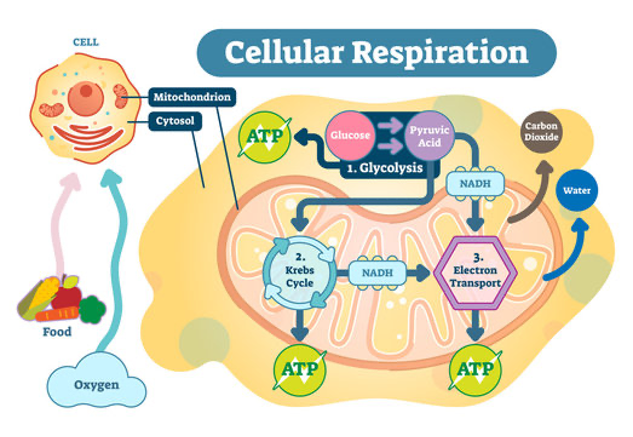At the core of every action the body performs are tiny organelles known as mitochondria that work around the clock to provide fuel and energy. They are considered the “powerhouses” of the cell because they power nearly all cellular activities, support proper cellular function and play a key role in aging and overall health. Let’s take a closer look inside the world of mitochondria — how they work, enhancing their function through nutrition, what may contribute to their dysfunction and the consequences of dysfunction.
Microscopic Powerhouses with Macroscopic Benefits
Mitochondria are found in all cells within the body. Cells that are energy-hungry, such as those in muscles and the brain, rely heavily on healthy mitochondrial function, and may contain thousands of mitochondria, while other cells may have fewer. To produce energy, mitochondria perform cellular respiration, a 3-step process that converts nutrients into adenosine triphosphate (ATP). ATP is the primary energy currency of cells that stores and transfers energy, powering various cellular activities, from muscle contraction to molecular synthesis
This graphic illustrates the cellular respiration process, where glycolysis breaks down glucose into pyruvate, which then enters the mitochondria and initiates the Krebs Cycle. The released electrons are then passed through the Electron Transport Chain, all while creating ATP.

Mitochondria also play a crucial role in regulating cellular processes like apoptosis (programmed cell death), which is necessary for removing old or damaged cells, and autophagy, which helps the body recycle cellular components. These processes keep the cells healthy and operating efficiently.
Enhancing Mitochondrial Function through Nutrients
Nutrition is one of the most powerful ways to improve mitochondrial health. Certain nutrients, like B vitamins, magnesium, alpha lipoic acid and coenzyme Q10, are essential for ATP production.
Urolithin A, a compound produced by gut bacteria from ellagitannins, promotes the cleanup and regeneration of mitochondria, which can help restore their function. Urolithin A stimulates mitophagy, a process where damaged or dysfunctional mitochondria are selectively degraded and removed from cells. This ensures that only the healthiest, most efficient mitochondria remain active in cells. Urolithin A also supports the creation of new mitochondria—a process known as mitochondrial biogenesis.
Certain botanicals such as ginseng, berberine, pomegranate, black cumin and ashwagandha also support healthy mitochondrial function. French oak extract in particular has recently garnered attention for its multi-action benefits for mitochondria health. Not only does French oak stimulate urolithin A production in the body, the extract supports synthesis of ribosomes, the cornerstone of cellular growth. Read more on French oak extract »
What Contributes to Mitochondrial Dysfunction?
One of the main contributors to mitochondrial dysfunction is oxidative stress. Excess reactive oxygen species, exposure to poor air quality and environmental toxins, such as heavy metals, pesticides, and pollutants, chronic inflammation and even certain illnesses can impair mitochondrial function by increasing oxidative stress and disrupting cellular signaling pathways. Numerous lifestyle factors also contribute to oxidative stress, including smoking, living a sedentary lifestyle and having an unhealthy diet.
Age is another key contributor to mitochondrial dysfunction since mitochondrial health tends to decline with age. This is partly due to cumulative oxidative damage, decreased mitochondrial biogenesis, and a reduction in the body’s natural antioxidant defense systems.
What are the Consequences of Mitochondrial Dysfunction?
When mitochondria function is compromised, the entire body feels the effects. This mitochondrial dysfunction can lead to widespread fatigue, increased oxidative stress, cellular damage and reduced vitality. With damaged mitochondrial function and fewer mitochondria, ATP production decreases. Cells and tissues, particularly in high-energy demand areas like muscles and the brain, cannot operate at full capacity. As cells struggle to produce enough energy, muscle cells may become weak and experience slow recovery after physical exertion, resulting in muscle fatigue. Brain cells can’t efficiently carry out neurotransmission, resulting in cognitive fatigue, brain fog, and difficulty concentrating. Immune cells may struggle to fight off infections, contributing to weakened immunity, which can further drain energy reserves.
These consequences can lead to further mitochondrial dysfunction, perpetuating a cycle of low energy and fatigue. Mitochondrial dysfunction is a key factor in the aging process, the development of various age-related disease and the general decrease in vitality and energy.

Final Thoughts
The mitochondria are called the powerhouse of the cell for good reason— they work tirelessly to fuel the body’s every move, from the beating of the heart to the blinking of an eye. While they play a central role in energy production, their function is also critical to cellular health, healthy aging and overall wellness. Nurturing the mitochondria through nutrients may optimize energy levels, slow down the negative effects associated with aging and minimize risk of mitochondrial dysfunction.
References
Zhaolin, Zeng, et al. (2022). Insights Into the Role of Mitochondria in Vasc Calcification. Frontiers in Cardiovasc Med. 9. 879752.

